Portable work box
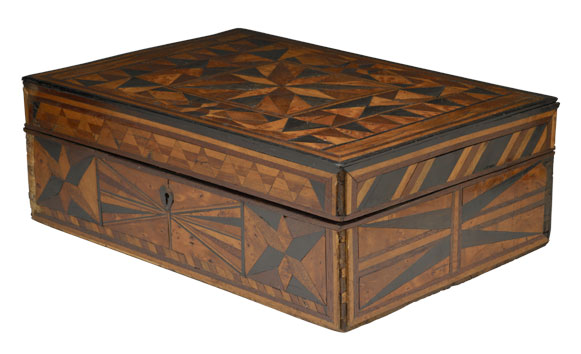
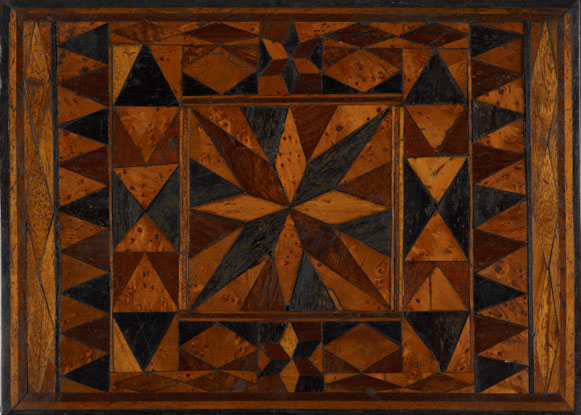
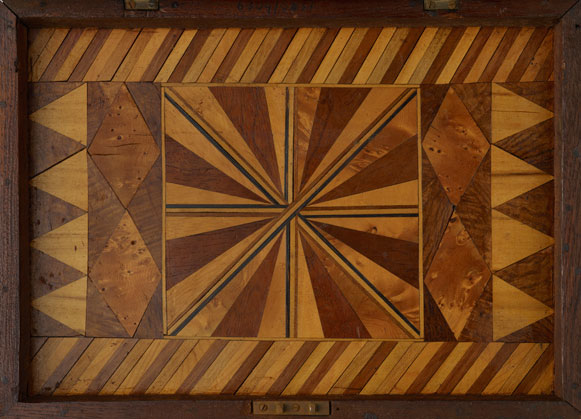
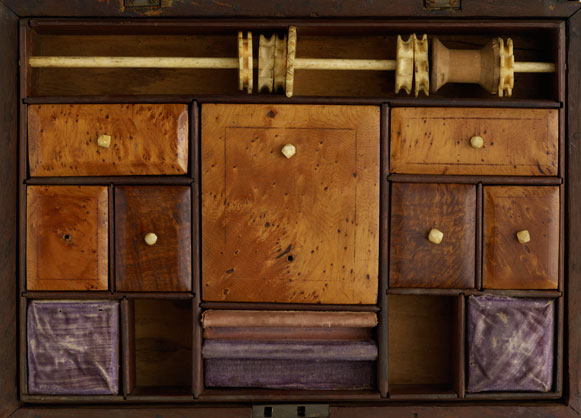
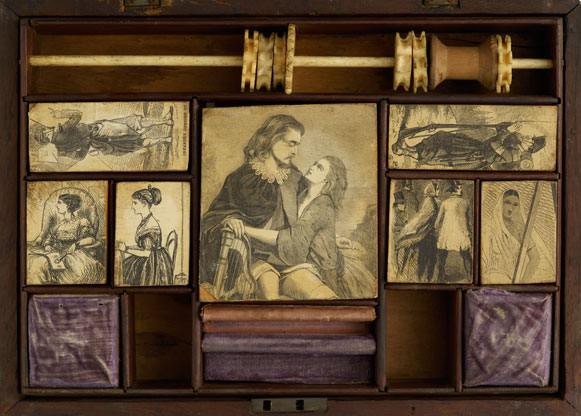
Portable work box
c. 1865
Captain Michael Reynolds (b.1830 Hobart)
wood (Baltic pine, Huon pine, Australian red cedar, Oyster Bay pine, casuarina, honeysuckle, ebony); metal (brass and steel fittings)
12 h x 33.4 w x 24.3 d cm
Presented by Captain J Reynolds, 1942
S231
Provenance
The workbox was presented to the Tasmanian Museum and Art Gallery in 1942 by Captain J Reynolds, the son of its maker, Captain Michael Reynolds.
History
The form of Captain Reynolds’ portable work box; a small, hinged box fitted with compartments for sewing articles and thread winders, is typical of the mid-nineteenth century. The box itself is well made with dovetail joints visible at the damaged corners. However, the elaborate parquetry is clearly the work of a dedicated amateur. The pieces are comparatively roughly fitted and poorly laid, resulting in poor adhesion and an uneven surface. Such items were often made as gifts marking important relationships or events.
Captain Michael Reynolds was born in Hobart, Tasmania, in 1830. At the age of sixteen, he embarked on a maritime career, sailing aboard a whaling vessel headed for the Pacific. By 1870 he was the captain of the whaling brig Victoria when it was wrecked just off the Tasmanian west coast. The crew were forced to abandon the ship and were picked up and returned to Hobart up by another whaler, The Maid of Erin. Reynolds was married in the same year to Lucy Ellen Stanhope (b.1845). It is possible that this box was for Lucy as a love token or wedding gift. Beginning with shore-based whaling on the Derwent, whaling became a very important industry in colonial Tasmania and the colony owned no small part of its wealth to it. By the 1840s whalers began to move to deep-sea whaling in the pacific. The industry steadily declined from the late 1870s and the last Tasmanian-based ship returned to port in 1900.
Description
Rectangular wooden work box with hinged lid and parquetry decoration in several Tasmanian timbers. The interior is fitted with a lift-out tray of lidded and unlidded compartments, pincushions and a bone reel holder. The exterior parquetry decoration is geometric. The lid has a central rectangular panel with an eight-pointed star, framed by three bands of stringing in contrasting timbers. Around the central panel are symmetrically arranged bands of triangular patterns. At the centre of the upper and lower sides is a larger motif of interlocking cubes. The front of the lid is decorated with triangles made up of alternating bands of different coloured woods. The sides and back have continuous diagonal banding.
The lower front of the box proper has a large rectangular panel in the centre with a heart-shaped escutcheon placed on vertical stringing that divides the panel in half. Meeting at the stringing are radiating triangular slithers of various veneers. To either side of the central panel are smaller panels with eight-pointed stars in various timbers. The sides of the box are evenly divided by triple strings of veneers along the horizontal and vertical axes. The remaining quartered panels of Huon pine veneer are further divided by triangles of dark wood radiating from the centre to the corners (resembling a Union Jack). The back of the box has four large diamonds of Huon pine veneer against a ground of various darker timbers.
The interior of the lid is decorated with a central square panel with a star-burst pattern. Above and below this are panels of diagonal banding while the sides feature a patterned band made up of triangles. The box is fitted with a tray divided into compartments. Along the top of the tray is a reel holder fitted with six turned bone winders. In the centre there is a large lidded compartment with a Huon pine veneered lid, the underside of which is pasted with a newsprint image of a woman (the Maid of Erin?) and a gentleman in antique dress holding a harp. To either side of this compartment there are three lidded compartments. The two larger ones have pasted newsprint images of soldiers while the four smaller ones have images of various subjects: a woman sitting in an armchair holding a fan; a young woman sitting at a table on a bentwood chair; an outdoor scene with a well-dressed man and woman; and a dark-skinned woman wearing a loose-fitting robe. The remaining section of the box is fitted with two padded pincushions covered with purple velvet, two unlined wells and a central compartment divided in two and lined with fabric.
Statement of Significance
The Tasmanian Museum and Art Gallery seeks to build a comprehensive representation of decorative arts made in Tasmania throughout the colonial period. Many of the objects in this collection are similar to contemporaneous objects made in Britain, but are distinguished by an idiosyncratic inflection derived from the colonial context of their production. The elaborate geometric decoration of this work box suggests that it was a labour of love, specifically intended as a gift. This idea is supported to some degree by the fact that it remained in the family. The use of Tasmanian native timbers also suggests a growing identification on the part of the maker with the particular characteristics of the colonial environment.
Inscriptions
None visible
References
Archives Office of Tasmania: Seaman Michael Reynolds departs on the Maguasha, to the South Seas on a whaling voyage. 15 Dec. 1846. [CUS36/1/353]

© 2009 Tasmanian Museum and Art Gallery
This page was last modified on :
26 August, 2010

